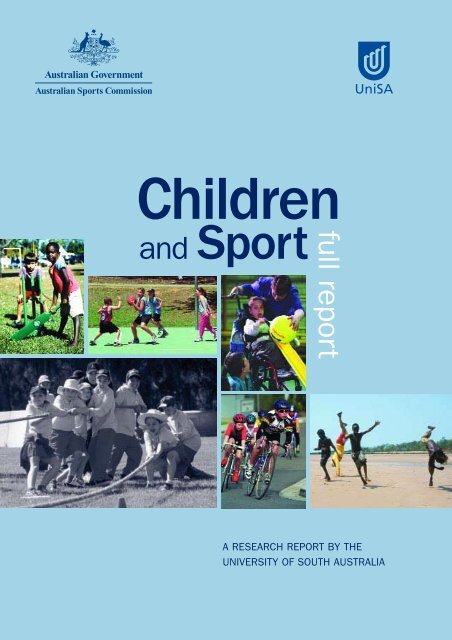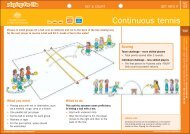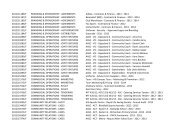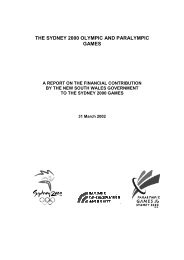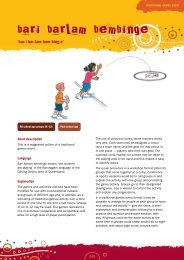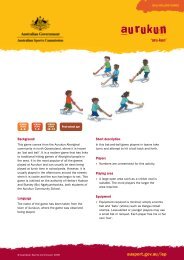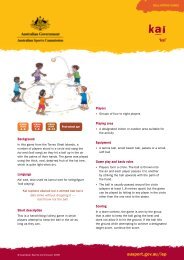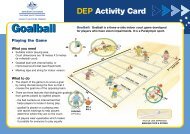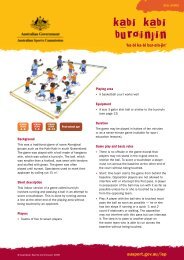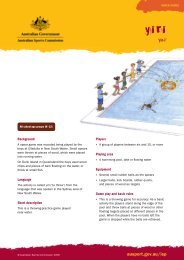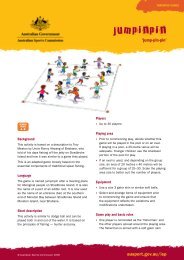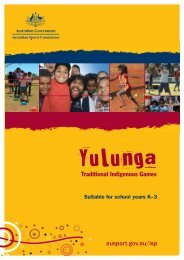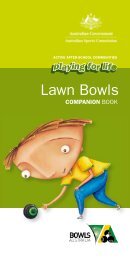References - Australian Sports Commission
References - Australian Sports Commission
References - Australian Sports Commission
Create successful ePaper yourself
Turn your PDF publications into a flip-book with our unique Google optimized e-Paper software.
Children<br />
and Sport<br />
full report<br />
A RESEARCH REPORT BY THE<br />
UNIVERSITY OF SOUTH AUSTRALIA
part 7<br />
<strong>References</strong>
112 © <strong>Australian</strong> <strong>Sports</strong> <strong>Commission</strong> – Children & Sport – Part 8: <strong>References</strong>
Active Australia National Physical Activity Survey 1997. (1998). <strong>Australian</strong> <strong>Sports</strong><br />
<strong>Commission</strong>, Canberra. Retrieved February 2, 2004, from<br />
http://www.ausport.gov.au/partic/report.pdf<br />
<strong>Australian</strong> Institute of Health and Welfare. (2003). AIHW Bulletin, Issue 11. Retrieved February<br />
2, 2004, from http://www.aihw.gov.au/publications/aus/bulletin11/bulletin11.pdf<br />
<strong>Australian</strong> Institute of Health and Welfare. (2003). AIHW Media Release. Retrieved February<br />
2, 2004, from http://www.aihw.gov.au/media/2003/mr031017b.html<br />
Ainsworth, B.E., Haskell, W.L., Whitt, M.C., Irwin, M.L., Swartz, A.M., Strath, S.J., O'Brien,<br />
W.L., Bassett, D.R., Schmitz, K.H., Emplaincourt, P.O., Jacobs, D.R., Leon, A.S. (2000).<br />
Compendium of physical activities: an update of activity codes and MET intensities.<br />
Medicine and Science in <strong>Sports</strong> and Exercise, 32(9) Suppl., s498-s516.<br />
Anderson, R., Crespo, C., Bartlett, S., Cheskin, L., & Pratt, M. (1998). Relationship of physical<br />
activity and television watching with body weight and level of fatness among children.<br />
Journal of the American Medical Association, 279, 938-942.<br />
Anonymous. (1974). Infant and adult obesity. The Lancet, 17-18.<br />
<strong>Australian</strong> Bureau of Statistics. (1998). <strong>Australian</strong> social trends. Canberra: ABS.<br />
<strong>Australian</strong> Bureau of Statistics. (1999). <strong>Australian</strong> social trends. Canberra: ABS.<br />
<strong>Australian</strong> Bureau of Statistics. (2001). 2001 year book Australia. ABS Catalogue No. 1301.0.<br />
Canberra: ABS.<br />
<strong>Australian</strong> Bureau of Statistics. (2001a). 2001 year book Australia. Canberra: AGPS.<br />
<strong>Australian</strong> Bureau of Statistics. (2001a). <strong>Australian</strong> social trend. Canberra: AGPS.<br />
<strong>Australian</strong> Bureau of Statistics. (2001a). Involvement in organised sport and physical activity.<br />
Canberra: ABS.<br />
<strong>Australian</strong> Bureau of Statistics. (2001b). 2001 year book Australia, Canberra: AGPS.<br />
<strong>Australian</strong> Bureau of Statistics. (2001b). <strong>Australian</strong> social trends. Canberra: ABS.<br />
<strong>Australian</strong> Bureau of Statistics. (1995). <strong>Australian</strong> social trends. Canberra: ABS.<br />
<strong>Australian</strong> Bureau of Statistics. (1997). Participation in sport and physical activities, 1995-96.<br />
(No. ABS Cat. No. 4177.0.), Canberra: ABS.<br />
<strong>Australian</strong> Bureau of Statistics. (1998). <strong>Australian</strong> social trends. Canberra: ABS.<br />
<strong>Australian</strong> Bureau of Statistics. (1999). <strong>Australian</strong> social trends. Canberra: ABS.<br />
<strong>Australian</strong> Bureau of Statistics. (2001a). <strong>Australian</strong> social trends. Canberra: ABS.<br />
<strong>Australian</strong> Bureau of Statistics. (2001b). Children’s participation in cultural and leisure<br />
activities. Canberra: ABS.<br />
<strong>Australian</strong> <strong>Sports</strong> <strong>Commission</strong>. (1991). Sport for young <strong>Australian</strong>s: Widening the gateway to<br />
participation. Canberra: ASC.<br />
<strong>Australian</strong> <strong>Sports</strong> <strong>Commission</strong>. (2003). Getting the goss; the findings of the 2002-2003 Youth<br />
Sport Issues Forums. Canberra: ASC.<br />
Bailey, D., & Martin, A. (1994). Physical activity and skeletal health in adolescents. Pediatric<br />
Exercise Science, 6, 406-423.<br />
Bandura, A (1986). Social foundations of thought and action: A social cognitive theory.<br />
Englewood Cliffs, NJ: Prentice-Hall.<br />
Bao, W., Srinivasan, S.R., Wattigney, W.A., & Berenson, G.S. (1994). Persistence of multiple<br />
cardiovascular risk clustering related to syndrome X from childhood to young adulthood.<br />
The Bogalusa Heart Study. Archives of International Medicine, 154(16), 1842-1847.<br />
© <strong>Australian</strong> <strong>Sports</strong> <strong>Commission</strong> – Children & Sport – Part 7: <strong>References</strong> 113
Baranowski, T, Simons-Morton, B, Hooks, P, Henske, J, Tiernan, K, Dunn, JK, Burkhalter, H,<br />
Harper, J & Palmer, J. (1990). A center-based program for exercise change among Black-<br />
American families. Health Education Quarterly, 17, 179-196.<br />
Bar-Or, O., & Baranowski, T. (1994). Physical activity, adiposity, and obesity among<br />
adolescents. Pediatric Exercise Science, 6, 348-360.<br />
Battle, E.K. & Brownell, K.D. (1996). Confronting a rising tide of eating disorders and obesity:<br />
treatment vs prevention and policy. Addictive Behaviors, 21, 755-765.<br />
Bauman, A., Owen, N., & Rushworth, R.L. (1990). Recent trends and sociodemographic<br />
determinants of exercise participation in Australia. Community Health Studies (14), 19-26.<br />
Bauman, AE, Sallis, JF, Dzewaltowski, DA, & Olwen, N. (2002). Towards a better<br />
understanding of the influences on physical activity: the role of determinants, correlates,<br />
causal variables, mediators, moderators and confounders. American Journal of Preventive<br />
Medicine, 23(2S), 5-14.<br />
Baur, L.A. (1997). Obesity in childhood - consequences, aetiology and management. Paper<br />
presented at the HINS National Nutritional Symposium, Melbourne.<br />
Beckett, L., Rosner, B., Roche, A., & Guo, S. (1992). Serial changes in blood pressure from<br />
adolescence to adulthood. American Journal of Epidemiology, 10, 1166-1177.<br />
Berg, M., & Medrich, E.A. (1980). Children in four neighborhoods: the physical environment<br />
and its effect on play and play patterns. Environment and Behavior, 12(3), 320-348.<br />
Berkey, C.S., Rockett, H.R.H., Gillman, M.W., & Colditz, G. (2003). One-year changes in<br />
activity and in inactivity among 10- to 15-year-old boys and girls: relationship to change in<br />
body mass index. Pediatrics, 111(4), 836-843.<br />
Beunen, G., & Thomis, M. (1999). Genetic determinants of sports participation and daily<br />
physical activity. International Journal of Obesity and Related Metabolic Disorders,<br />
23(Suppl 3), S55-63.<br />
Bloomfield, J. (1973). Report on the role, scope and development of recreation in Australia,<br />
Canberra: Commonwealth Department of Tourism and Recreation.<br />
Booth, M., Chey, T., Wake, M., Norton, K., Hesketh, K., Dollman, J., & Robertson, I. (2003).<br />
Change in the prevalence of overweight and obesity among young <strong>Australian</strong>s. American<br />
Journal of Clinical Nutrition, 77(1), 29-36.<br />
Booth, M.L., Macaskill, P., & McLellan, L. (1997). NSW schools fitness and physical activity<br />
survey, 1997. Sydney: NSW Department of School Education.<br />
Booth, M.L., Macaskill, P., Lazarus, R., & Baur, L.A. (1999). Sociodemographic distribution of<br />
measures of body fatness among children and adolescents in New South Wales, Australia.<br />
International Journal of Obesity, 23, 456-462.<br />
Booth, M.L., Wake, M., Armstrong, T., Chey, T., Hesketh, K., & Mathur, S. (2001). The<br />
epidemiology of overweight and obesity among <strong>Australian</strong> children and adolescents, 1995-1997.<br />
<strong>Australian</strong> and New Zealand Journal of Public Health, 25(2), 155-161.<br />
Boreham, C.A., Twisk, J., Savage, Cran, G.W., & Strain, J.J. (1997). Physical activity, sports<br />
participation, and risk factors in adolescents. Medicine and Science in <strong>Sports</strong> and Exercise,<br />
29(6), 788-793.<br />
Bouchard, C. (1994). Overview and research directions. In C. Bouchard (Ed.), The genetics of<br />
obesity (pp. 223-233). Boca Raton, FL: CRC Press.<br />
Bradley, C.B., McMurray, R.G., Harrell, J.S., & Deng, S. (2000). Changes in common activities<br />
of 3rd through 10th graders: the CHIC study. Medicine and Science in <strong>Sports</strong> and Exercise,<br />
32(12), 2071-2078.<br />
114 © <strong>Australian</strong> <strong>Sports</strong> <strong>Commission</strong> – Children & Sport – Part 7: <strong>References</strong>
Brown, R., Lewis, F., Murtagh, M., Thorpe, S., & Collins, R. (1999). 100 minutes project:<br />
researching PE and sport in DETE schools. Adelaide: Flinders University of South<br />
Australia.<br />
Calfas, K., & Taylor, W. (1994). Effects of physical activity on psychological variables in<br />
adolescents. Pediatric Exercise Science, 6, 406-423.<br />
Campbell, K., Waters, E., O’Meara, S., Kelly, S., & Summerbell, C. (2002). Interventions for<br />
preventing obesity in children (Cochrane Review). Cochrane Database Systematic Reviews<br />
(2), CD001871.<br />
Carlin, J.B., Stevenson, M.R., Roberts, I., Bennett, C.M., Gelman, A., & Nolan, T. (1997).<br />
Walking to school and traffic exposure in <strong>Australian</strong> children. <strong>Australian</strong> and New Zealand<br />
Journal of Public Health, 21(3), 286-292.<br />
Caspersen, C.J., Pereira, M.A., & Curran, K.M. (2000). Changes in physical activity patterns in<br />
the United States, by sex and cross-sectional age. Medicine and Science in <strong>Sports</strong> and<br />
Exercise, 32(9), 1601-1609.<br />
Caspersen, C.J., & Zack, M.M. (1997). The prevalence of physical inactivity in the United States. In<br />
AS Leon (Ed.), Physical activity and cardiovascular health: A national consensus (pp 32-39).<br />
Champaign, IL: Human Kinetics.<br />
Cavill, N., Biddle, S., & Sallis, J.F. (2001). Health enhancing physical activity for young<br />
people: statement of the United Kingdom Expert Consensus Conference. Pediatric Exercise<br />
Science, 13, 12-25.<br />
Chinn, S., & Rona, R.J. (2001). Prevalence and trends in overweight and obesity in three cross<br />
sectional studies of British children, 1974-94. British Medical Journal, 322(7277), 24-26.<br />
Colchico, K., Zybert, P., & Basch, C.E. (2000). Effects of after-school physical activity on<br />
fitness, fatness, and cognitive self-perceptions: A pilot study among urban minority<br />
adolescent girls. American Journal of Public Health, 90(6), 977-978.<br />
Colditz, G.A. (1999). The economic costs of obesity and physical inactivity. Med Sci <strong>Sports</strong><br />
Exercise (31), s663-s667.<br />
Colditz, G.A., Cannuscio, C.C., & Grazier, A.L. (1997). Physical activity and reduced risk of<br />
colon cancer. Cancer causes and control (8), 647-667.<br />
Cole, T.J., Bellizzi, M., Flegal, K., & Dietz, W.H. (2000). Establishing a standard definition<br />
for child overweight and obesity worldwide: International survey. British Medical Journal,<br />
320, 1-6.<br />
Connell, F. (1957). Growing up in an <strong>Australian</strong> city. Melbourne: <strong>Australian</strong> Council for<br />
Education Research.<br />
Coogan, P.F., Newcomb, P.A., & Clapp, R.W. (1997). Physical activity in usual occupation and<br />
risk of breast cancer (US). Cancer Causes and Control (8), 626-631.<br />
Corbin, C., & Pangrazi, R.P. (1992). Are American children and youth fit? Research Quarterly<br />
for Exercise and Sport, 63(2), 96-106.<br />
Cunningham, C., & Jones, M. (1991). Girls and boys come out to play: Play, gender and urban<br />
planning. Landscape Australia, 13(4), 305-311.<br />
d’Agostino, R.B., & Pearson, E.S. (1973). Tests of departure from normality: Empirical results<br />
for the distribution of b2 and √b1. Biometrika, 60, 613-622.<br />
Dempsey, K. (1990). Smalltown-a study of social inequality, cohesion and belonging. Melbourne:<br />
Oxford University Press.<br />
Department of Health and Ageing. (1999). National Physical Activity Guidelines. Canberra:<br />
AGPS.<br />
© <strong>Australian</strong> <strong>Sports</strong> <strong>Commission</strong> – Children & Sport – Part 7: <strong>References</strong> 115
Dietz, W., & Gortmaker, S. (1985). Do we fatten our children at the television set? Obesity and<br />
television viewing in children and adolescents. Pediatrics, 75, 807-812.<br />
Dollman, J (2003). Trends and sociodemographic distribution of children’s health-related<br />
fitness and behaviours. Unpublished thesis. University of South Australia: Adelaide.<br />
Dollman, J. Trends in body composition among <strong>Australian</strong> children: The role of physical<br />
activity. Presentation to the Public Health Association (SA) Forum on Childhood Obesity,<br />
October, Adelaide, 2003.<br />
Dollman, J. (2002). Psychosocial and environmental correlates of physical activity among 11year-old<br />
South <strong>Australian</strong>s. Paper presented at the <strong>Australian</strong> Conference of Science and<br />
Medicine in Sport, Melbourne.<br />
Dollman, J. (2003). Trends and sociodemographic distribution of children’s health-related<br />
fitness and behaviours. Unpublished PhD thesis. University of South Australia: Adelaide.<br />
Dollman, J., Norton, K., & Tucker, G. (2002). Anthropometry, fitness and physical activity of<br />
urban and rural South <strong>Australian</strong> children. Pediatric Exercise Science, 14(3), 297-312.<br />
Dollman, J., Olds, T., & Norton, K. (2000). The relationship between socioeconomic status and<br />
children’s health-related fitness. 2000 Pre-Olympic Congress, Brisbane, Australia, 7-13<br />
September.<br />
Dollman, J., Olds, T., Norton, K., & Stuart, D. (1999). The evolution of fitness and fatness in<br />
10-11 year old <strong>Australian</strong> schoolchildren: Changes in distributional characteristics between<br />
1985 and 1997. Pediatric Exercise Science, 11(2), 108-121.<br />
Drinkwater, B. (1994) Physical activity, fitness and osteoporosis. In C. Bouchard (Ed.),<br />
Physical activity and health (pp. 724-726). USA: Human Kinetics Press.<br />
Dunstan, D.W., Zimmet, P.Z., Wellborn, T.A., Cameron, A.J., Shaw, J., de Courten, M., Jolley,<br />
D., & McCarty, D.J. (2002). The <strong>Australian</strong> diabetes, obesity and lifestyle study (AusDiab) –<br />
Methods and response rates. Diabetes Res Clin Pract (57), 119-129.<br />
Dwyer, J.T., Stone, E.T., Yang, M., Feldman, H., Webber, L.S., Must, A., Perry, C.L., Nader, P.R.,<br />
& Parcel, G.S. (1998). Predictors of overweight and overfatness in a multiethnic pediatric<br />
population. American Journal of Clinical Nutrition, 67, 602-610.<br />
Dwyer, T., Coonan, W.E., Leitch, D.R., Hetzel, B.S., & Baghurst, P.A. (1983). An investigation<br />
of the effects of daily physical activity on the health of primary school students in South<br />
Australia. International Journal of Epidemiology, 12, 308-313.<br />
Engstom, L. (1991). Exercise adherence in sport for all from youth to adulthood. In P. Oja & R.<br />
Telama (Eds.), Sport for all. Amsterdam: Elsevier Science.<br />
Epstein, L.H., & Roemmich, J.N. (2001). Reducing sedentary behaviour, role in modifying physical<br />
activity. Exercise and Sport Science Reviews, 29(3), 103-108.<br />
Fagard, R.H., & Tipton, C.M. (1994). Physical activity, fitness and hypertension. In C.<br />
Bouchard (Ed.), Physical Activity and Health (pp. 633-655). USA: Human Kinetics Press.<br />
Fereira-Molero, E. R. (1981). Neighbourhood environment and children’s experience of play.<br />
Dissertation Abstracts International, 42(2A), 611.<br />
Flegal, K., Harlan, W., & Landis, J. (1990). Secular trends in the body mass in the United<br />
States, 1960-1980. American Journal of Epidemiology, 132, 196-197.<br />
Frank, L., & Pivo, G. (1994). Impacts of mixed use and density on utilization of three modes of<br />
travel: Single-occupant vehicle, transit and walking. Transportation Research Record, 1466,<br />
44-52.<br />
Freeman, C. (1995). Planning and play: Creating greener environments. Children’s<br />
Environments, 12(3), 381-388.<br />
116 © <strong>Australian</strong> <strong>Sports</strong> <strong>Commission</strong> – Children & Sport – Part 7: <strong>References</strong>
Garn, S., Leonard, W., & Hawthorne, V. (1986). Three limitations of the body mass index.<br />
American Journal of Clinical Nutrition, 44, 996-997.<br />
Gaster, S. (1991). Urban children’s access to their neighborhood, changes over three generations.<br />
Environment and Behavior, 23(1), 70-85.<br />
Gerritsen, R. (2000). The management of government and its consequences for service delivery in<br />
regional Australia. In B Pritchard & P McManus (Eds.), The dynamics of change in rural and<br />
regional Australia. Sydney: UNSW Press.<br />
Gill, T., Taylor, A., MacDougall, C., Schiller, W. & Darbyshire, P. (2003). Is fear a barrier to<br />
children’s participation in sport? Presentation to the Public Health Association (SA),<br />
Adelaide, 2003.<br />
Gortmaker, S.L., Must, A., Sobol, A.M., Peterson, K., Colditz, G.A., & Dietz, W.H. (1996).<br />
Television viewing as a cause of increasing obesity among children in the United States,<br />
1986-1990. Archives of Pediatric and Adolescent Medicine, 150(4), 356-362.<br />
Greendorfer, S.L., & Ewing, M.E. (1981). Race and gender differences in children’s<br />
socialization into sport. Res Q Exerc Sport, 52, 301-310.<br />
Guo, S., Beckett, L., Chumlea, W., Gardner, J., & Siervogel, R. (1993). Serial analysis of<br />
plasma lipid and lipoproteins from 9 to 21 years. American Journal of Clinical Nutrition, 58,<br />
61-67.<br />
Guo, S., Roche, A., Chumlea, W., Gardner, J., & Siervogel, R. (1994). The predictive value of<br />
childhood body mass index values for overweight at age 35 y. American Journal of Clinical<br />
Nutrition, 59 (810-819).<br />
Hair, J.F., Anderson, R.E., Tatham, R.L., & Black, W.C. (1998). Multivariate data analysis (5th<br />
ed.). Englewood Cliffs, NJ: Prentice Hall.<br />
Harris, J.R. (1999). The nurture assumption. New York: Bloomsbury.<br />
Harten, N., & Olds, T.S. (2004). Patterns of active transport in 9-12 year old <strong>Australian</strong><br />
children. <strong>Australian</strong> and New Zealand Journal of Public Health (in press).<br />
Harten, N.R., Olds, T.S. & Dollman, J. . (2002). The effect of available play space on children’s<br />
freeplay activity. Paper presented at the <strong>Australian</strong> Conference of Science and Medicine in<br />
Sport, Melbourne.<br />
Hatziandreu, E., Koplan, J., & Weinstein, M. (1988). A cost-effectiveness analysis of exercise<br />
as a health promotion activity. American Journal of Public Health 78, 1417-1421.<br />
Helmrich, S., Ragland, D.R., & Paffenbarger R.S. (1994). Prevention of non insulin dependent<br />
diabetes mellitus with physical activity. Medicine and Science in Sport and Exercise 26, 824-<br />
830.<br />
Hernandez, B., Gortmaker, S.L., Colditz, G.A., Peterson, K.E., Laird, N.M., & Parra-Cabrera, S.<br />
(1999). Association of obesity with physical activity, television programs and other forms of<br />
video viewing among children in Mexico City. International Journal of Obesity, 23, 845-<br />
854.<br />
Hill, A. (2002). Children’s use of time. Unpublished Honours thesis, University of South<br />
Australia: Adelaide.<br />
Hill, A., & Silver, E. (1995). Fat, friendless and unhealthy: 9-year-old children’s perception of<br />
body shape stereotypes. International Journal of Obesity and Related Metabolic Disorders,<br />
19(6), 423-430.<br />
Hogan, K., & Norton, K. (2000). The “price” of Olympic gold. Journal of Science and<br />
Medicione in Sport, 3(2), 203-210.<br />
© <strong>Australian</strong> <strong>Sports</strong> <strong>Commission</strong> – Children & Sport – Part 7: <strong>References</strong> 117
Hoos, M., Gerver, W., Kester, A., & Westerterp, K. (2003). Physical activity levels in children<br />
and adolescents. International Journal of Obesity and Related Metabolic Disorders, 27, 605-<br />
609.<br />
Hughes, J.M., Li, L., Chinn, S., & Rona, R.J. (1997). Trends in growth in England and Scotland,<br />
1972 to 1994. Archives of Diseases in Childhood, 76(3), 182-189.<br />
Ingram, D. (2000). Age-related declines in physical activity: generalization to nonhumans.<br />
Medicine and Science in <strong>Sports</strong> and Exercise, 32, 1623-1628.<br />
International Society for the Advancement of Kinanthropometry (2001). International<br />
standards for anthropometric assessment. Adelaide: ISAK.<br />
International Society for the Advancement of Kinanthropometry. (2001). International<br />
standards for anthropometric assessment. Adelaide, Australia: ISAK.<br />
Janz, K.F., Burns, T.L., Torner, J.C., Levy, S.M., Paulos, R., Willing, M.C., & Warren J.J.<br />
(2001). Physical activity and bone measures in young children: The Iowa bone development<br />
study. Pediatrics, 107(6), 1387-1393.<br />
Janz, K.F., & Mahoney, L.T. (1997). Maturation, gender, and video game playing are related to<br />
physical activity intensity in adolescents: The Muscatine study. Pediatric Exercise Science,<br />
9, 353-363.<br />
Jolliffe, D. (2004). Extent of overweight among US children and adolescents from 1971 to<br />
2000. International Journal of Obesity and Related Metabolic Disorders, 28(1), 4-9.<br />
Katzmarky, P.T., Gledhill, N., & Shepherd, R.J. (2000). The economic burden of physical<br />
inactivity in Canada. CMAJ (163), 1435-1440.<br />
Kaufman, F.R. (2002). Type 2 diabetes mellitus in children and youth: a new epidemic. Journal<br />
of Pediatric Endocrinology and Metabolism, 15 (Suppl 2), 737-744.<br />
Kelder, S.H., Perry, C.L., & Klepp, K.I. (1993). Community-wide youth exercise promotion:<br />
Long term outcomes of the Minnesota heart health program and the class of 1989 study.<br />
Journal of School Health, 63, 218-223.<br />
Kimiecik, J.C., Horn, T.S., & Shurin, C.S. (1996). Relationships among children’s beliefs,<br />
perceptions of their parents’ beliefs, and their moderate-to-vigorous physical activity. Research<br />
Quarterly for Exercise and Sport, 67(3), 324-336.<br />
Kimm, S.Y.S., Glynn, N.W., Kriska, A.M., Fitzgerald, S.L., Aaron, D.J., Similo, S.L.,<br />
McMahon, R.P., & Barton, B.A. (2000). Longitudinal changes in physical activity in a<br />
biracial cohort during adolescence. Medicine and Science in <strong>Sports</strong> and Exercise, 32(8),<br />
1445-1454.<br />
Kirk, D., Carlson, T., O’Connor, A., Burke, P., Davis, K., & Glover, S. (1997). The economic<br />
impact on families of children’s participation in junior sport. The <strong>Australian</strong> Journal of Science<br />
and Medicine in Sport, 29(2), 27-33.<br />
Klesges, R.C., Shelton, M.L., & Klesges, L.M. (1993). Effects of television on metabolic rate:<br />
Potential implications for childhood obesity. Pediatrics, 91(2), 281-286.<br />
Kutner, M.H., Nachtschiem, C.J., Wasserman, W., & Neter, J.N. (1996). Applied Linear<br />
Statistical Models (4th ed.). Chicago, IL: Irwin.<br />
Lazarus, R., Wake, M., Hesketh, K., & Waters, E. (2000). Changes in body mass index in <strong>Australian</strong><br />
primary school children 1985-1997. International Journal of Obesity, 24, 679-684.<br />
Lazarus, R., Wake, M., Hesketh, K., & Waters, E. (2000). Change in body mass index in<br />
<strong>Australian</strong> primary school children, 1985-1997. International Journal of Obesity, 24, 679-<br />
684.<br />
Lindquist, C.H., Reynolds, K.D., & Goran, M.I. (1999). Sociocultural determinants of physical<br />
activity among children. Preventive Medicine, 29, 305-312.<br />
118 © <strong>Australian</strong> <strong>Sports</strong> <strong>Commission</strong> – Children & Sport – Part 7: <strong>References</strong>
Lobstein, T., & Frelut, M.L. (2003). Prevalence of overweight among children in Europe.<br />
Obesity Reviews, 4(4), 195-200.<br />
Longhurst, K., & Spink, K.S. (1987). Participation motivation of <strong>Australian</strong> children involved in<br />
organized sport. Canadian Journal of Sport Sciences, 12(1), 24-30.<br />
Lord, S. (1994). The effect of a 12-month exercise on balance, strength and falls in older<br />
women. Journal of American Geriatrics Society (48), 1198-1206.<br />
Luepker, R.V., Perry, C.L., McKinlay, S.M., Nader, P.R., Parcel, G., Stone, E.J., Webber, L.S.,<br />
Elder, J.P., Feldman, H.A., Johnson, C.C., Kelder, S.H., & Wu, H. (1996). Outcomes of a<br />
field trial to improve children’s dietary patterns and physical activity: The child and<br />
adolescent trial for cardiovascular health (CATCH). Journal of the American Medical<br />
Association, 275, 768-776.<br />
Luo, J., & Hu, F.B. (2002). Time trends of obesity in pre-school children in China from 1989 to<br />
1997. International Journal of Obesity and Related Metabolic Disorders, 26(4), 553-558.<br />
MacDougall, C., Schiller, W., Darbyshire, P., & Williams, M. (2003). Listening to<br />
children's voices: The South <strong>Australian</strong> Physical Activity For Children Campaign.<br />
South Australia Department of Human Services Abstracts. Retrieved 21 April 2004<br />
from www.eventedge.com.au:8080/npac/Abstracts.pdf.<br />
Magarey, A.M., Daniels, L.A., & Boulton, T.J. (2001). Prevalence of overweight and obesity in<br />
<strong>Australian</strong> children and adolescents: Reassessment of 1985 and 1995 data against new<br />
standard international definitions. Medical Journal of Australia, 174(11), 561-564.<br />
Mahoney, M., Townsend, M., Nesbitt, P., & Hallebone, E. (1998). Healthy families and<br />
communities – the implications of rural decline and changes in policy and practice: Hopetoun<br />
and Penshurst Community report. Unpublished Deakin University report.<br />
Malina, R. (1996). Tracking of physical activity and physical fitness across the lifespan.<br />
Research Quarterly for Exercise and Sport, 67(3), 48-57.<br />
Marshall, S.J., Biddle, S.J.H., Sallis, J.F., McKenzie, T.L., & Conway, T.L. (2002). Clustering<br />
of sedentary behaviors and physical activity among youth: A cross-national study. Pediatric<br />
Exercise Science, 14(4), 401-417.<br />
Marshall, S.J., Sarkin, J.A., Sallis, J.F., & McKenzie, T.L. (1998). Tracking of health-related<br />
fitness components in youth aged 9 to 12. Medicine and Science in <strong>Sports</strong> and Exercise,<br />
30(6), 910-916.<br />
Martin, M., Dollman, J., Norton, K. & Robertson, I. (n.d.). A decrease in the association<br />
between the physical activity patterns of <strong>Australian</strong> parents and their children, 1985-1997.<br />
Accepted by Journal of Science and Medicine in Sport.<br />
McKenzie, T.L., Nader, P.R., Strikmiller, P.K., Yang, M., Stone, E.J., Perry, C.L., Taylor,<br />
W.C., Epping, J.N., Feldman, H.A., Luepker, R.V. & Kelder, S.H. (1996). School physical<br />
education: Effect of the child and adolescent trial for cardiovascular health. Preventive<br />
Medicine, 25, 423-431.<br />
McMurray, R.G., Harrell, J.S., Bangdiwala, S.I., & Hu, J. (2003). Tracking of physical activity<br />
and aerobic power from childhood through adolescence. Medicine and Science in <strong>Sports</strong> and<br />
Exercise, 35(11), 1914-1922.<br />
McMurray, R.G., Harrell, J.S., Bangdiwala, S.I., & Gangsky, S.A. (1995). Biologic and<br />
environmental factors influencing the aerobic power of children. Medicine, Exercise, Nutrition<br />
and Health, 4, 243-250.<br />
McNaughton, L., Morgan, R., Smith, P., & Hannan, G. (1996). An investigation into the fitness<br />
levels of Tasmanian primary schoolchildren. The ACHPER Healthy Lifestyles Journal, 43(1), 4-<br />
10.<br />
© <strong>Australian</strong> <strong>Sports</strong> <strong>Commission</strong> – Children & Sport – Part 7: <strong>References</strong> 119
McNaughton, L., Morgan, R., Smith, P., & Hannan, G. (1996). An investigation into the fitness<br />
levels of Tasmanian primary schoolchildren. The ACHPER Healthy Lifestyles Journal,<br />
43(1), 4-10.<br />
Merni, F., & Carbonaro, G. (1981). Test motori. Rome: Comitato Olimpico Nazionale Italiano.<br />
Mezzich, J.E. (1978). Evaluating clustering methods for psychiatric diagnosis. Biological<br />
Psychiatry, 13, 265-281.<br />
Milligan, G.W. (1980). An examination of the effects of six types of error perturbation on<br />
fifteen clustering algorithms. Psychometrika, 45, 325-342.<br />
Ministry of Culture and Tourism. (1998). National survey of physical fitness. Seoul: Korean<br />
<strong>Sports</strong> Institute.<br />
Ministry of Education Science and Culture. (1999). Statistical abstract of education, science<br />
and culture. Tokyo: Ministry of Education, Science and Culture.<br />
Ministry of Education. (1999). Statistical year book of education. Seoul: Ministry of Education.<br />
Moore, R.C. (1986). Childhood’s domain: Play and place in child development. London: Croom<br />
Helm.<br />
Moreno, L.A., Sarria, A., Fleta, J., Rodriguez, G., & Bueno, M. (2000). Trends in body mass index<br />
and overweight prevalence among children and adolescents in the region of Aragon (Spain) from<br />
1985 to 1995. International Journal of Obesity, 24, 925-931.<br />
Morris, S., Sallybanks, J., & Willis, K. (2003). Sport, physical activity and antisocial behaviour<br />
in youth. Research and Public Policy Series (49). Canberra: <strong>Australian</strong> Institute of<br />
Criminology.<br />
Morrow, J., & Freedson, P. (1994). Relationship between habitual physical activity and aerobic<br />
fitness in adolescents. Pediatric Exercise Science, 6, 315-329.<br />
Mota, J., & Esculcas, C. (2002). Leisure-time physical activity behavior: Structured and<br />
unstructured choices according to sex, age and level of physical activity. International<br />
Journal of Behavioral Medicine, 9(2), 111-121.<br />
Moussa, M.A.A., Skaik, M.B., Selwanes, S.B., Yaghy, O.Y., & Bin-Othman, S.A. (1994).<br />
Factors associated with obesity in school children. International Journal of Obesity, 18,<br />
513-515.<br />
Munro, J., Brazier, J., Davey, R., & Nicholl, J. (1997). Physical activity for the over-65s: Could<br />
it be a cost effective exercise for the NHS? Journal of Public Health Medicine (19), 397-402.<br />
Must, A., Jacques, P., Dallal, G., Bajema, C., & Dietz, W.H. (1992). Long-term morbidity and<br />
mortality of overweight adolescents. New England Journal of Medicine, 327 (1350-1355).<br />
Nader, P.R., Sallis, J.F., Patterson, T.L., Abramson, I.S., Rupp, J., Senn, K.L., Atkins, C.J.,<br />
Roppe, B.E., Morris, J.A., Wallace, J.P., & Vega, W.A. (1989). A family approach to<br />
cardiovascular risk reduction: Results from the San Diego Family Health Project. Health<br />
Education Quarterly, 16, 229-244.<br />
Nielson, A.C. (2000). TV trends. B & T Weekly.<br />
North, T., MCCullagh, P., & Tran, Z. (1990). Effect of exercise on depression. Exercise and<br />
Sport Sciences Reviews, 18, 379-415.<br />
Norton, K., Dollman, J., Klanarong, S., & Robertson, I. (2001). Kids’ sport: Who’s playing<br />
what? Sport Health 19(3), 12-14, 2001.<br />
Norton, K., Dollman J., & Norton, L. (2003) The obesogenic environment: Childhood<br />
overweight and obesity in Australia. Adelaide, South Australia: Government of South<br />
Australia, Department of Human Services, ISBN 0 86803 701 X.<br />
Norton, K., Smith, M., Dollman J., & Williams, M. (2003). GOSH: Games out of school hours.<br />
Adelaide, South Australia: Government of South Australia, Department of Human Services.<br />
120 © <strong>Australian</strong> <strong>Sports</strong> <strong>Commission</strong> – Children & Sport – Part 7: <strong>References</strong>
NSW Childhood Obesity Summit Communiqué. (2002). NSW: NSW Parliament.<br />
Nuegut, A., Terry, M.N., & Hocking, G. (1996). Leisure and occupational physical activity and<br />
risk of colorectal adenomatous polyps. International Journal of Cancer (68), 744-748.<br />
Olds, T., Dollman, J., Norton, K., & Harten, N. (2001). A century of growth in <strong>Australian</strong><br />
children. In T. Jurimae & A. Hills (Eds.), Body composition assessment in children and<br />
adolescents, medicine and sport science, 44, 85-103. Basel: Karger.<br />
Olds, T.S., & Dollman, J. (2004). Are secular declines in children’s ærobic fitness explained by<br />
changes in fatness? Pediatric Exercise Science (in press).<br />
Olds, T.S., & Harten, N.R. (2001). One hundred years of growth: the evolution of height, mass,<br />
and body composition in <strong>Australian</strong> children: 1899-1999. Human Biology, 73(5), 727-738.<br />
Olds, T.S., & Tomkinson, G.R. (2003). The ærobic fitness of 9-15-year-old South <strong>Australian</strong><br />
children: Norms, evolution and international comparisons. ACHPER Healthy Lifestyles<br />
Journal, 30(3-4), 25-30.<br />
Olds, T.S., Tomkinson, G.R., & Baker, S. (2003). Fitness differentials between schools: How<br />
are they related to school sector? Journal of Science and Medicine in Sport, 6(3), 315-329.<br />
Olds, T., Tomkinson, G., Léger, L., & Cazorla, G. (2004). Worldwide variation in children's<br />
fitness. A meta-analysis of 109 studies of the 20 m shuttle run from 37 countries. Submitted.<br />
Pate, R., Trost, R., Felton, G., & Ward, D. (1997). Correlates of physical activity behavior in<br />
rural youth. Research Quarterly for Exercise and Sport, 68, 241-248.<br />
Pate, R.R., Saunders, R.P., Ward, D.S., Felton, G., Trost, S.G., & Dowda, M (2003). Evaluation<br />
of a community-based intervention to promote physical activity in youth: Lessons from<br />
active winners. American Journal of Health Promotion, 17(3): 171-182.<br />
Pérusse, L., Tremblay, A., Leblanc, C., & Bouchard, C. (1989). Genetic and environmental<br />
influences on level of habitual activity and exercise participation. American Journal of<br />
Epidemiology, 129(5), 1012-1022.<br />
Popkin, B.M., Richards, M.K., & Montiero, C.A. (1996). Stunting is associated with overweight<br />
in children of four nations that are undergoing the nutrition transition. J Nutr, 126(12), 3009-<br />
3016.<br />
Pratt, M., Macera, C.A., & Blanton, C. (1999). Levels of physical activity and inactivity in children<br />
and adults in the United States, current evidence and research issues. Medicine and Science in<br />
Sport and Exercise, 31(11), S526-S533.<br />
Prentice, A.M., & Jebb, S.A. (1995). Obesity in Britain: Gluttony or sloth? British Medical<br />
Journal, 311, 437-439.<br />
Proctor, M.H., Moore, L.L., Gao, D., Cupples, L.A., Bradlee, M.L., Hood, M.Y., & Ellison,<br />
R.C. (2003). Television viewing and change in body fat from preschool to early adolescence:<br />
The Framingham Children’s Study. International Journal of Obesity and Related Metabolic<br />
Disorders, 27(7), 827-833.<br />
Przeweda, R., & Trzesniowski, R. (1996). Sprawnosc fizyczna Polskiej mlodziezy w swietle<br />
badan z roku. Warsaw: Akademia Wychowania Fizycznego.<br />
Pung, G., & Stewart, D.W. (1983). Cluster analysis in marketing research: Review and<br />
suggestions for applications. Journal of Marketing Research, 20, 134-148.<br />
Pyke, J. <strong>Australian</strong> health and fitness survey 1985. Adelaide: <strong>Australian</strong> Council for Health,<br />
Physical Education and Recreation, 1987.<br />
Riddoch, C.J., & Boreham, C.A.G. (1995). The health-related physical activity of children.<br />
<strong>Sports</strong> Medicine, 19(2), 86-102.<br />
Ridley, K, Dollman, J & Olds, T (2001). Development and validation of a computer delivered<br />
physical activity questionnaire (CDPAQ) for children. Pediatric Exercise Science, 13(1), 35-46.<br />
© <strong>Australian</strong> <strong>Sports</strong> <strong>Commission</strong> – Children & Sport – Part 7: <strong>References</strong> 121
Ridley, K., & Olds, T.S. (2001). Video centre games: energy cost and children’s behaviour.<br />
Pediatric Exercise Science, 13, 413-421.<br />
Ridley, K., Olds, T., & Hill, A. (2002). A multimedia activity recall for children and adolescents<br />
(MARCA) – description and validation. Journal of Science and Medicine in Sport, 5(4),<br />
s113.<br />
Roberts, A., Holmes, G., Thac, C., & Oppenheim, P. (1987). The economic benefits of<br />
participation in regular physical activity. Recreation Ministers Council of Australia.<br />
Robertson, I. (2003). A hindsight perspective about the future of teenagers in physical activity.<br />
Physical Education and Sport. Adelaide: Department of Education and Training.<br />
Robinson, T.N. (1999). Reducing children’s television viewing to prevent obesity. Journal of<br />
the American Medical Association, 282(16), 1561-1567.<br />
Robinson, T.N., Hammer, L.D., Killen, J.D., Kraemer, H.C., Wilson, D.M., Hayward, C., &<br />
Taylor, C.B. (1993). Does television viewing increase obesity and reduce physical activity?<br />
Cross-sectional and longitudinal analyses among adolescent girls. Pediatrics, 91(2), 273-<br />
280.<br />
Roede, M.J. (1990). The secular trend in the Netherlands: The Third Nation Wide Growth Study.<br />
Arztl Judendkd, 81, 330-336.<br />
Ross, J., Hargreaves, J. & Cowley, V. (1995). The demise of school physical education with<br />
deregulation. Paper presented at the Proceedings of the ANZALS Conference, Canterbury.<br />
Rowlands, A., Ingledew, D., & Eston, R. (2000). The effect of type of physical activity measure<br />
on the relationship between body fatness and habitual physical activity in children: A metaanalysis.<br />
Annals of Human Biology, 27(5), 479-497.<br />
Sahota, P.M., Rudolph, R., Dixey, A., Hill, J., Barth, J., & Cade, J. (2001a). Evaluation of<br />
implementation and effect of primary school based intervention to reduce risk factors for<br />
obesity. British Medical Journal, 323, 1027-1029.<br />
Sahota, P.M., Rudolph, R., Dixey, A., Hill, J., Barth, J., & Cade, J. (2001b). Randomised<br />
controlled trial of primary school based intervention to reduce risk factors for obesity. British<br />
Medical Journal, 323, 1029-1032.<br />
Salbe, A.D., Weyer, C., Harper, I., Lindsay, R.S., Ravussin, E., & Tataranni, P.A. (2002).<br />
Assessing risk factors for obesity between childhood and adolescence II: Energy metabolism<br />
and physical activity. Pediatrics, 110(2 Pt 1), 307-314.<br />
Sallis, J., Taylor, W.C., Dowda, M., Freedson, P., & Pate, R.R. (2002). Correlates of vigorous<br />
physical activity for children in Grades 1 through 12: Comparing parent-reported and objectively<br />
measured physical activity. Pediatric Exercise Science, 14, 30-44.<br />
Sallis, J. (2000). Age-related decline in physical activity: A synthesis of human and animal<br />
studies. Medicine and Science in <strong>Sports</strong> and Exercise, 32(9), 1598-1600.<br />
Sallis, J.F., Conway, T.L., Prochaska, J.J., McKenzie, T.L., Marshall, S.J., & Brown, M. (2001).<br />
The association of school environments with youth physical activity. American Journal of<br />
Public Health, 91(4), 618-620.<br />
Sallis, J.F. (1993). Epidemiology of physical activity and fitness in children and adolescents.<br />
Critical Reviews in Food Science and Nutrition, 33, 405-408.<br />
Sallis, J.F., Prochaska, J.J., & Taylor, W.C. (2000). A review of correlates of physical activity<br />
of children and adolescents. Medicine and Science in <strong>Sports</strong> and Exercise, 32(5), 963-975.<br />
Sallis, J.F., Taylor, W.C., Dowda, M., Freedson, P.S., & Pate, R.R. (2002). Correlates of<br />
vigorous physical activity for children in grades 1 through 12: Comparing parent-reported<br />
and objectively measured physical activity. Pediatric Exercise Science, 14, 30-44.<br />
Sallis, J.F., & Owen, N. (1999). Physical activity and behavioural medicine. Thousand Oaks,<br />
California: Sage Publications.<br />
122 © <strong>Australian</strong> <strong>Sports</strong> <strong>Commission</strong> – Children & Sport – Part 7: <strong>References</strong>
Sallis, J.F., Alcarez, J.E., McKenzie, T.L., Hovell, M., Kolody, B. & Nader, P.R. (1992). Parental<br />
behavior in relation to physical activity and fitness in 9-year-old children. American Journal of<br />
Diseases in Children, 146, 1383-1388.<br />
Sallis, J.F., McKenzie, T.L., Alcaraz, J.E., Kolody, B., Faucette, N., & Hovell, MF (1997).<br />
Effects of a 2-year health-related physical education program on physical activity and fitness<br />
in elementary school students: SPARK. American Journal of Public Health, 87, 1328-1334.<br />
Sallis, J.F., Patterson, T.L., McKenzie, T.L., & Nader, P.R. (1988). Family variables and<br />
physical activity in preschool children. Journal of Developmental and Behavioral Pediatrics,<br />
9, 57-61.<br />
Sallis, J.F., Proschaska, J.J. & Taylor, W.C. (2000). A review of correlates of physical activity of<br />
children and adolescents. Medicine and Science in Sport and Exercise, 32(5), 963-975.<br />
Salmon, J. (2003). Children’s physical activity and obesogenic environments. Presentation to<br />
the Public Health Association (SA) forum on childhood obesity, October, Adelaide, 2003.<br />
Salmon, J., Bauman, A., Crawford, D., Timperio, A., & Owen, N. (2000). The association<br />
between television viewing and overweight among <strong>Australian</strong> adults participating in varying<br />
levels of leisure-time physical activity. International Journal of Obesity, 24, 600-606.<br />
Saunders, P. (2001). Income and welfare: Centenary article – Household income and its<br />
distribution. Canberra: <strong>Australian</strong> Bureau of Statistics.<br />
Shephard, R. (1997). Curricular physical activity and acedemic performance. Pediatric<br />
Exercise Science, 9, 113-125.<br />
Schofield, L., Mummery, K., Schofield, G., & Walmsely, H. (2002). Adolescent girls and<br />
inactivity: Insights from the Central Queensland adolescent physical activity and nutrition<br />
study. The ACHPER Healthy Lifestyles Journal, 49(2), 17-22.<br />
Shriver, K. (1997). Influence of environmental design on pedestrian travel behavior in four<br />
Austin neighborhoods. Transportation Research Record, 1578, 64-75.<br />
Shropshire, J. & Carroll, R. (1997). Family variables and children’s physical activity: influence of<br />
parental exercise and socioeconomic status. Sport, Education and Society, 2(1), 95-116.<br />
Sibley, B.A., & Etnier, J.L. (2003). The relationship between physical activity and cognition in<br />
children: A meta-analysis. Pediatric Exercise Science, 15, 243-256.<br />
Simons-Morton, B.G., Parcel, G.C., Baranowski, T., Forthofer, R., & O’Hara, N.M. (1991).<br />
Promoting physical activity and a healthful diet among children: results of a school-based<br />
intervention study. American Journal of Public Health, 81, 986-991.<br />
Simons-Morton, B.G., Taylor, W.C., Snider, S.A., Huang, I.W., & Fulton, J.E. (1994).<br />
Observed levels of elementary and middle school children’s physical activity during physical<br />
education classes. Preventive Medicine, 23, 437-441.<br />
Sirard, J., & Pate, R. (2001). Physical activity assessment in children and adolescents. <strong>Sports</strong><br />
Medicine, 31(6), 439-455.<br />
Slater, M.D., & Flora, J.A. (1991). Health lifestyles: Audience segmentation analysis for public<br />
health interventions. Health Education Quarterly, 18(2), 221-233.<br />
Slattery, M., Potter, J., & Caan, B. (1997). Energy balance and colon cancer – Beyond physical<br />
activity. Cancer Research (57), 75-80.<br />
Smith, M.A., & Claxton, D.B. (2003). Using active homework in physical education. Journal of<br />
Physical Education Recreation and Dance, 74(5): 28-34.<br />
Statistical Package for the Social Sciences (Version 11.0.1). (2002). Chicago, IL: SPSS Inc.<br />
Stephenson, J., Bauman, A., Armstrong, T., Smith, B., & Bellew, B. (2000). The costs of illness<br />
attributable to physical inactivity in Australia – A preliminary study. Canberra:<br />
© <strong>Australian</strong> <strong>Sports</strong> <strong>Commission</strong> – Children & Sport – Part 7: <strong>References</strong> 123
Commonwealth Department of Health and Aged Care and the <strong>Australian</strong> <strong>Sports</strong><br />
<strong>Commission</strong>.<br />
Stone, E.J., McKenzie, T.L., Welk, G.J., & Booth, M.L. (1998). Effects of physical activity<br />
interventions in youth, review and synthesis. American Journal of Preventive Medicine,<br />
15(4), 298-315.<br />
Suits, B. (1989). Tricky triad: Games, sport and play. Journal of the Philosophy of Sport,<br />
XV, 1-9.<br />
Sunnegardt, J., Bratteby, L.E. & Sjodin, S. (1985). Physical activity and sports involvement in 8- and<br />
13-year-old children in Sweden. Acta Paediatrica Scandinavica, 74, 904-912.<br />
Suter, E., & Hawes, M.R. (1993). Relationship of physical activity, body fat, diet, and blood<br />
lipid profile in youths 10-15 yrs. Medicine and Science in <strong>Sports</strong> and Exercise, 25(6), 748-<br />
754.<br />
Tandy, C.A. (1999). Children’s diminishing playspace, a study of intergenerational change in<br />
children’s use of their neighbourhoods. <strong>Australian</strong> Geographical Studies, 37(2), 154-164.<br />
Taylor, A.F., Wiley, A., Kuo, F.E., & Sullivan, W.C. (1998). Growing up in the inner city:<br />
Green spaces as places to grow. Environment and Behavior, 30(1), 3-27.<br />
Telama, R., & Yang, X. (2000). Decline of physical activity from youth to young adulthood in<br />
Finland. Medicine and Science in <strong>Sports</strong> and Exercise, 32(9), 1617-1622.<br />
Terre, L., Ghiselli, W., & Taloney, L. (1992). Demographics, affect, and adolescents’ health<br />
behaviours. Adolescence, 27, 12-24.<br />
Thompson, S.H. (1996). Weight-related attitudes and practices of adolescent males. The Physical<br />
Educator, 53(2), 102-112.<br />
Thune, I., Brenn, T., & Lund, E. (1997). Physical activity and the risk of breast cancer. NEJM<br />
(336), 1269-1275.<br />
Toh, C. (2002). School-based intervention has reduced obesity in Singapore. British Medical<br />
Journal, 324, 427.<br />
Tomkinson, G.R., Olds, T.S., & Gulbin, J. (2003). Secular trends in physical performance of<br />
<strong>Australian</strong> children. Journal of <strong>Sports</strong> Medicine and Physical Fitness, 43, 90-98.<br />
Tomkinson, G.R., Léger, L., Olds, T., & Cazorla, G. (2003). Secular trends in the fitness of<br />
children and adolescents 1980-2000 – An analysis of 20 m shuttle run studies. <strong>Sports</strong><br />
Medicine, 33(4), 385-400.<br />
Tomkinson, G.R., Léger, L., Olds, T.S., & Cazorla, G. (2003). Secular trends in the<br />
performance of children and adolescents (1980-2000): An analysis of 55 studies of the 20m<br />
shuttle run test in 11 countries. <strong>Sports</strong> Medicine, 33(4), 285-300.<br />
Tomkinson, G.R., Olds, T.S., & Gulbin, J. (2003). Evolution of the fitness of <strong>Australian</strong><br />
children: Evidence from the Talent Search Program. Journal of <strong>Sports</strong> Medicine and<br />
Physical Fitness, 43(1), 90-98.<br />
Tomporowski, P.D. (2003). Cognitive and behavioral responses to acute exercise in youths: A<br />
review. Pediatric Exercise Science, 15, 348-359.<br />
Torun, B., Davies, P.S.W., Livingstone, M.B.E., Paolisso, M., Sackett, R., & Spurr, G.B.<br />
(1996). Energy requirements and dietary energy recommendations for children and<br />
adolescents 1 to 18 years old. European Journal of Clinical Nutrition, 50(1), s37-s81.<br />
Townsend, M., Moore, J. & Mahoney, M. (2002). Playing their part: The role of physical activity<br />
and sport in sustaining the health and well being of small rural communities. Rural and Remote<br />
Health, 2, 109. Retrieved from http://rrh.deakin.edu.au<br />
Tremblay, M., & Willms, J. (2003). Is the Canadian childhood obesity epidemic related to<br />
physical inactivity? International Journal of Obesity, 27, 1100-1105.<br />
124 © <strong>Australian</strong> <strong>Sports</strong> <strong>Commission</strong> – Children & Sport – Part 7: <strong>References</strong>
Tremblay, M.S., Katzmarzyk, P.T., & Willms, J.D. (2002). Temporal trends in overweight and<br />
obesity in Canada, 1981-1996. International Journal of Obesity and Related Metabolic<br />
Disorders, 26(4), 538-543.<br />
Troiano, R., Flegal, K., Kuczamrski, R., Campbell, S., & Johnson, C. (1995). Overweight<br />
prevalence and trends for children and adolescents. Archives of Pediatric and Adolescent<br />
Medicine, 149, 1085-1091.<br />
Troiano, R.P., Briefel, R.R., Carroll, M.D., & Bialostosky, K. (2000). Energy and fat intakes of<br />
children and adolescents in the United States: Data from the National Health and Nutrition<br />
Examination Surveys. American Journal of Clinical Nutrition, 72, s1343-s1353.<br />
Troiano, R.P., Flegal, K.M., Kuczamrski, R.J., Campbell, S.M., & Johnson, C.L. (1995).<br />
Overweight prevalence and trends for children and adolescents. Archives of Pediatric and<br />
Adolescent Medicine, 149, 1085-1091.<br />
Troiano, R.P., & Flegal, K.M. (1998). Overweight children and adolescents: Description,<br />
epidemiology, and demographics. Pediatrics, 101, 497-504.<br />
Trost, S., Ward, D., McGraw, B., & Pate, R. (1999). Validity of the previous day physical<br />
activity recall (PDPAR) in fifth-grade children. Pediatric Exercise Science, 11(4), 341-348.<br />
United States Surgeon General’s Report (USSG). (1996). Physical activity and health.<br />
Department of Health and Human Services, Washington, DC, and Center for Disease<br />
Control, Atlanta, Georgia: US Government Printing Office.<br />
Updyke, W., & Willett, M. (1989). Physical fitness trends in American youth 1980-1989. Press<br />
release. Bloomington IL: Chrysler Fund-AAU Physical Fitness Program.<br />
van Mechelen, W., Twisk, J.W.R., Bertheke Post, G., Snel, J., & Kemper, H.C.G. (2000).<br />
Physical activity of young people: The Amsterdam Longitudinal Growth and Health Study.<br />
Medicine and Science in <strong>Sports</strong> and Exercise, 32(9) Suppl., 1610-1616.<br />
van Mechelen, W.V., Twisk, J.W.R., Post, B.R., Snel, J., & Kemper, H.C.G. (2000). Physical<br />
activity of young people: the Amsterdam longitudinal growth and health study. Medicine and<br />
Science in <strong>Sports</strong> and Exercise, 32(9), 1610-1616.<br />
Vercauteren, M., & Susanne, C. (1985). The secular trend in height and menarche in Belgium: Are<br />
there any signs of a future stop? The European Journal of Pediatrics, 144, 306-309.<br />
Wake, M., Hesketh, K., & Waters, E. (2003). Television, computer use and body mass index in<br />
<strong>Australian</strong> primary school children. Journal of Paediatric and Child Health, 39(2), 130-134.<br />
Welk G.J., Wood, K., & Morss, G. (2003). Parental influences on physical activity in children:<br />
An exploration of potential mechanisms. Pediatric Exercise Science, 15, 19-33.<br />
Welk, G., Corbin, C., & Dale, D. (2000). Measurement issues in the assessment of physical<br />
activity in children. Research Quarterly for Exercise and Sport, 71(2), 59-73.<br />
Welk, G., Dzewaltowski, D., Ryan, G., Sepulveda-Jowers, E., & Hill, J. (2001). Convergent<br />
validity of the previous day physical activity recall and the activitygram assessment.<br />
Medicine and Science in <strong>Sports</strong> and Exercise, 33, s144.<br />
Welk, G.J. (1999). The youth physical activity promotion model: A conceptual bridge between<br />
theory and practice. Quest, 51, 5-23.<br />
Wheeler, D. (1961). The adolescent peer group and its activities. <strong>Australian</strong> Journal of Higher<br />
Education, 1, 33-38.<br />
World Health Organisation (2002). European health report, 2002. Retrieved January 10, 2003, from<br />
http://www.who.dk/eprise/main/who/prog/ehr/home<br />
World Health Organisation. (1998). Obesity: Preventing and managing the global epidemic.<br />
Report of a WHO consultation. Geneva: World Health Organisation.<br />
© <strong>Australian</strong> <strong>Sports</strong> <strong>Commission</strong> – Children & Sport – Part 7: <strong>References</strong> 125
Yang, X., Telama, R., & Laakso, L. (1996). Parents’ physical activity, socioeconomic status and<br />
education as predictors of physical activity and sport among children and youths – A 12-year<br />
follow-up study. International Review for Sociology of Sport, 31(3), 273-294.<br />
Youth Say Project (1974). The recreational priorities of <strong>Australian</strong> young people. National<br />
Youth Council of Australia.<br />
126 © <strong>Australian</strong> <strong>Sports</strong> <strong>Commission</strong> – Children & Sport – Part 7: <strong>References</strong>
© <strong>Australian</strong> <strong>Sports</strong> <strong>Commission</strong> – Children & Sport – Part 7: <strong>References</strong> 127


